Exploring Securigera securidaca Seeds as a Source of Potential CDK1 Inhibitors: Identification of Hippeastrine and Naringenin as Promising Hit Candidates
Abstract
:1. Introduction
2. Results and Discussion
2.1. GC/MS Analysis
2.2. HPLC Analysis
2.3. LC-MS/MS
2.4. Molecular Docking Studies
2.5. ADMET Prediction
2.6. Molecular Dynamic Simulations
3. Materials and Methods
3.1. Collection and Preparation of S. securidaca Seed Extracts
3.2. Preparation of S. securidaca Seed Extracts
3.2.1. GC/MS
3.2.2. Glycine Test
3.2.3. Glycoside Test
3.2.4. Flavonoids Test
3.2.5. Steroids Test
3.3. Instrumentation and MS Parameters
3.3.1. GC/MS
| Mobile Phase Grades | Time | |
| A (10% methanol with 0.1% formic acid) | 10–30 | 0–6.5 |
| 30–100 | 6.5–7 | |
| 100–10 | 8–8.5 | |
| 10 | 8.5–12.5 | |
| B (50% methanol with 0.1% formic acid) | 90–70 | 0–6.5 |
| 70–0 | 6.5–7 | |
| 0–90 | 8–8.5 | |
| 90 | 8.5–12.5 | |
3.3.2. HPLC
3.4. Molecular Docking
3.4.1. Protein Structure Preparation
3.4.2. Ligand Preparation
3.4.3. Molecular Docking Preparation
3.5. ADMET Prediction
3.6. Molecular Dynamics
3.7. Binding Free Energy Calculation Using MM/PBSA
4. Conclusions
Supplementary Materials
Author Contributions
Funding
Data Availability Statement
Conflicts of Interest
References
- Sung, H.; Ferlay, J.; Siegel, R.L.; Laversanne, M.; Soerjomataram, I.; Jemal, A.; Bray, F. Global Cancer Statistics 2020: GLOBOCAN Estimates of Incidence and Mortality Worldwide for 36 Cancers in 185 Countries. CA Cancer J. Clin. 2021, 71, 209–249. [Google Scholar] [CrossRef]
- Siegel, R.L.; Miller, K.D.; Fuchs, H.E.; Jemal, A. Cancer statistics, 2022. CA Cancer J. Clin. 2022, 72, 7–33. [Google Scholar] [CrossRef] [PubMed]
- Mehraj, U.; Dar, A.H.; Wani, N.A.; Mir, M.A. Tumor microenvironment promotes breast cancer chemoresistance. Cancer Chemother. Pharmacol. 2021, 87, 147–158. [Google Scholar] [CrossRef] [PubMed]
- Matthews, H.K.; Bertoli, C.; de Bruin, R.A. Cell cycle control in cancer. Nat. Rev. Mol. Cell Biol. 2022, 23, 74–88. [Google Scholar] [CrossRef]
- Panagopoulos, A.; Altmeyer, M. The Hammer and the Dance of Cell Cycle Control. Trends Biochem. Sci. 2020, 46, 301–314. [Google Scholar] [CrossRef] [PubMed]
- Mehraj, U.; Sofi, S.; Alshehri, B.; Mir, M.A. Expression pattern and prognostic significance of CDKs in breast cancer: An integrated bioinformatic study. Cancer Biomark. 2022, 34, 505–519. [Google Scholar] [CrossRef]
- Dang, F.; Nie, L.; Wei, W. Ubiquitin signaling in cell cycle control and tumorigenesis. Cell Death Differ. 2020, 28, 427–438. [Google Scholar] [CrossRef] [PubMed]
- Mehraj, U.; Aisha, S.; Sofi, S.; Mir, M.A. Expression pattern and prognostic significance of baculoviral inhibitor of apoptosis repeat-containing 5 (BIRC5) in breast cancer: A comprehensive analysis. Adv. Cancer Biol. Metastasis 2022, 4, 100037. [Google Scholar] [CrossRef]
- Bury, M.; Le Calvé, B.; Ferbeyre, G.; Blank, V.; Lessard, F. New Insights into CDK Regulators: Novel Opportunities for Cancer Therapy. Trends Cell Biol. 2021, 31, 331–344. [Google Scholar] [CrossRef]
- Qayoom, H.; Wani, A.; Alshehri, N.; Mir, M. An insight into the cancer stem cell survival pathways involved in chemoresistance in triple-negative breast cancer. Futur. Oncol. 2021, 17, 4185–4206. [Google Scholar] [CrossRef]
- Izadi, S.; Nikkhoo, A.; Hojjat-Farsangi, M.; Namdar, A.; Azizi, G.; Mohammadi, H.; Yousefi, M.; Jadidi-Niaragh, F. CDK1 in Breast Cancer: Implications for Theranostic Potential. Anticancer Agents Med. Chem. 2020, 20, 758–767. [Google Scholar] [CrossRef] [PubMed]
- Li, M.; He, F.; Zhang, Z.; Xiang, Z.; Hu, D. CDK1 serves as a potential prognostic biomarker and target for lung cancer. J. Int. Med. Res. 2020, 48. [Google Scholar] [CrossRef]
- Malumbres, M.; Barbacid, M. Cell cycle, CDKs and cancer: A changing paradigm. Nat. Rev. Cancer 2009, 9, 153–166. [Google Scholar] [CrossRef] [PubMed]
- Sofi, S.; Mehraj, U.; Qayoom, H.; Aisha, S.; Almilaibary, A.; Alkhanani, M.; Mir, M.A. Targeting cyclin-dependent kinase 1 (CDK1) in cancer: Molecular docking and dynamic simulations of potential CDK1 inhibitors. Med. Oncol. 2022, 39, 1–15. [Google Scholar] [CrossRef] [PubMed]
- García-Reyes, B.; Kretz, A.-L.; Ruff, J.-P.; von Karstedt, S.; Hillenbrand, A.; Knippschild, U.; Henne-Bruns, D.; Lemke, J. The Emerging Role of Cyclin-Dependent Kinases (CDKs) in Pancreatic Ductal Adenocarcinoma. Int. J. Mol. Sci. 2018, 19, 3219. [Google Scholar] [CrossRef]
- Wijnen, R.; Pecoraro, C.; Carbone, D.; Fiuji, H.; Avan, A.; Peters, G.J.; Giovannetti, E.; Diana, P. Cyclin Dependent Kinase-1 (CDK-1) Inhibition as a Novel Therapeutic Strategy against Pancreatic Ductal Adenocarcinoma (PDAC). Cancers 2021, 13, 4389. [Google Scholar] [CrossRef] [PubMed]
- Sung, W.-W.; Lin, Y.-M.; Wu, P.-R.; Yen, H.-H.; Lai, H.-W.; Su, T.-C.; Huang, R.-H.; Wen, C.-K.; Chen, C.-Y.; Chen, C.-J.; et al. High nuclear/cytoplasmic ratio of CDK1 expression predicts poor prognosis in colorectal cancer patients. BMC Cancer 2014, 14, 951. [Google Scholar] [CrossRef]
- Neganova, I.; Tilgner, K.; Buskin, A.; Paraskevopoulou, I.; Atkinson, S.P.; Peberdy, D.; Passos, J.F.; Lako, M. CDK1 plays an important role in the maintenance of pluripotency and genomic stability in human pluripotent stem cells. Cell Death Dis. 2014, 5, e1508. [Google Scholar] [CrossRef] [PubMed]
- Novak, B.; Tyson, J.J.; Gyorffy, B.; Csikasz-Nagy, A. Irreversible cell-cycle transitions are due to systems-level feedback. Nature 2007, 9, 724–728. [Google Scholar] [CrossRef] [PubMed]
- Nigg, E.A. Mitotic kinases as regulators of cell division and its checkpoints. Nat. Rev. Mol. Cell Biol. 2001, 2, 21–32. [Google Scholar] [CrossRef]
- Prevo, R.; Pirovano, G.; Puliyadi, R.; Herbert, K.J.; Rodriguez-Berriguete, G.; O’docherty, A.; Greaves, W.; McKenna, W.G.; Higgins, G.S. CDK1 inhibition sensitizes normal cells to DNA damage in a cell cycle dependent manner. Cell Cycle 2018, 17, 1513–1523. [Google Scholar] [CrossRef] [PubMed]
- Bendris, N.; Lemmers, B.; Blanchard, J.M. Cell cycle, cytoskeleton dynamics and beyond: The many functions of cyclins and CDK inhibitors. Cell Cycle 2015, 14, 1786–1798. [Google Scholar] [CrossRef] [PubMed]
- Saikat, A.S.M. An In Silico Approach for Potential Natural Compounds as Inhibitors of Protein CDK1/Cks2. Chem. Proc. 2021, 8, 5. [Google Scholar]
- Dias, D.A.; Urban, S.; Roessner, U. A Historical Overview of Natural Products in Drug Discovery. Metabolites 2012, 2, 303–336. [Google Scholar] [CrossRef]
- Atanasov, A.G.; Zotchev, S.B.; Dirsch, V.M.; Supuran, C.T. Natural products in drug discovery: Advances and opportunities. Nat. Rev. Drug Discov. 2021, 20, 200–216. [Google Scholar] [CrossRef] [PubMed]
- Huang, M.; Lu, J.-J.; Ding, J. Natural Products in Cancer Therapy: Past, Present and Future. Nat. Prod. Bioprospect. 2021, 11, 5–13. [Google Scholar] [CrossRef]
- Cragg, G.M.; Pezzuto, J.M. Natural Products as a Vital Source for the Discovery of Cancer Chemotherapeutic and Chemopreventive Agents. Med. Princ. Pract. 2015, 25, 41–59. [Google Scholar] [CrossRef]
- Ahmadi, A.; Khalili, M.; Salimi, M.; Mirsistani, N.; Niksirat, A.; Nazirzadeh, S. The Effects of Solvent Polarity on Analgesic and Anti-Inflammatory Activities of Securigera Securidaca (L.), Achillea Eriophora DC, and Portulaca Oleracea Extracts. Pharm. Chem. J. 2019, 53, 248–263. [Google Scholar] [CrossRef]
- Ahmadipour, B. Securigera securidaca seed medicinal herb supplementation of diets improves pulmonary hypertensive response in broiler chickens reared at high altitude. J. Anim. Physiol. Anim. Nutr. 2018, 102, 1601–1607. [Google Scholar] [CrossRef]
- Aldal’in, H.K.; Al-Mazaideh, G.; Al-Nadaf, A.H.; Al-Rimawi, F.; Afaneh, A.T.; Marashdeh, A.; Jamhour, R.M. Phytochemical Constituents of Securigera securidaca Seed Extract Using GS-MS and HPLC. Trop. J. Nat. Prod. Res. 2020, 4, 540–544. [Google Scholar]
- Alizadeh-Fanalou, S.; Babaei, M.; Bahreini, E. Effects of Securigera Securidaca Seed Extract, Alone and in combination with Glibenclamide, on Circulating Levels of Pro-Angiogenic/Anti-Angiogenic Biomarkers in Hyperglycemic Rats. 2020. Available online: https://doi.org/10.21203/rs.3.rs-52508/v1 (accessed on 18 December 2022).
- Al Mazaideh, G.M.; Al Quran, S.A. Effect of Methanolic Extract of Securigera securidaca as Antioxidant and Antibacterial Activities. J. Pharm. Res. Int. 2020, 10–17. [Google Scholar] [CrossRef]
- Garjani, A.; Fathiazad, F.; Zakheri, A.; Akbari, N.A.; Azarmie, Y.; Fakhrjoo, A.; Andalib, S.; Maleki-Dizaji, N. The effect of total extract of Securigera securidaca L. seeds on serum lipid profiles, antioxidant status, and vascular function in hypercholesterolemic rats. J. Ethnopharmacol. 2009, 126, 525–532. [Google Scholar] [CrossRef] [PubMed]
- Lu, X.; Yu, H.; Ma, Q.; Shen, S.; Das, U.N. Linoleic acid suppresses colorectal cancer cell growth by inducing oxidant stress and mitochondrial dysfunction. Lipids Health Dis. 2010, 9, 106. [Google Scholar] [CrossRef]
- Amelio, I.; Cutruzzolá, F.; Antonov, A.; Agostini, M.; Melino, G. Serine and glycine metabolism in cancer. Trends Biochem. Sci. 2014, 39, 191–198. [Google Scholar] [CrossRef]
- Fukuda, T.; Ito, H.; Mukainaka, T.; Tokuda, H.; Nishino, H.; Yoshida, T. Anti-tumor Promoting Effect of Glycosides from Prunus persica Seeds. Biol. Pharm. Bull. 2003, 26, 271–273. [Google Scholar] [CrossRef]
- Newmark, J.; Brady, R.O.; Grimley, P.M.; Gal, A.E.; Waller, S.G.; Thistlethwaite, J.R. Amygdalin (Laetrile) and prunasin beta-glucosidases: Distribution in germ-free rat and in human tumor tissue. Proc. Natl. Acad. Sci. USA 1981, 78, 6513–6516. [Google Scholar] [CrossRef]
- Kashyap, D.; Sharma, A.; Tuli, H.S.; Sak, K.; Punia, S.; Mukherjee, T.K. Kaempferol—A dietary anticancer molecule with multiple mechanisms of action: Recent trends and advancements. J. Funct. Foods 2017, 30, 203–219. [Google Scholar] [CrossRef]
- Arya, P.; Kumar, P. Diosgenin a steroidal compound: An emerging way to cancer management. J. Food Biochem. 2021, 45, e14005. [Google Scholar] [CrossRef] [PubMed]
- El Sayed, A.M.; Basam, S.M.; El-Naggar, E.-M.B.A.; Marzouk, H.S.; El-Hawary, S. LC–MS/MS and GC–MS profiling as well as the antimicrobial effect of leaves of selected Yucca species introduced to Egypt. Sci. Rep. 2020, 10, 1–15. [Google Scholar] [CrossRef]
- Meng, X.-Y.; Zhang, H.-X.; Mezei, M.; Cui, M. Molecular Docking: A Powerful Approach for Structure-Based Drug Discovery. Curr. Comput. Aided-Drug Des. 2011, 7, 146–157. [Google Scholar] [CrossRef] [PubMed]
- Shalayel, M.H.; Al-Mazaideh, G.M.; Swailmi, F.K.A.; Aladaileh, S.; Nour, S.; Afaneh, A.T.; Marashdeh, A. Molecular docking evaluation of syzygium aromaticum isolated compounds against Exo-β-(1, 3)-glucanases of Candida albicans. J. Pharm. Res. Int. 2021, 32, 34–44. [Google Scholar] [CrossRef]
- Shalayel, M.H.; Al-Mazaideh, G.M.; Aladaileh, S.H.; Al-Swailmi, F.K.; Al-Thiabat, M.G. Vitamin D is a potential inhibitor of COVID-19: In silico molecular docking to the binding site of SARS-CoV-2 endoribonuclease Nsp15. Pak. J. Pharm. Sci. 2020, 33. [Google Scholar] [CrossRef]
- GC-MS/Phytolab-0322/2008; National Organization for Drug Control and Research (NODCAR): Cairo, Egypt, 2008.
- Rodriguez-Garcia, M.; Surman, A.J.; Cooper, G.J.; Suárez-Marina, I.; Hosni, Z.; Lee, M.P.; Cronin, L. Formation of oligopeptides in high yield under simple programmable conditions. Nat. Commun. 2015, 6, 8385. [Google Scholar] [CrossRef] [PubMed]
- Bolarinwa, I.F.; Orfila, C.; Morgan, M.R. Amygdalin content of seeds, kernels and food products commercially—Available in the UK. Food Chem. 2014, 152, 133–139. [Google Scholar] [CrossRef]
- Du, X.; Li, Y.; Xia, Y.-L.; Ai, S.-M.; Liang, J.; Sang, P.; Ji, X.-L.; Liu, S.-Q. Insights into protein–ligand interactions: Mechanisms, models, and methods. Int. J. Mol. Sci. 2016, 17, 144. [Google Scholar] [CrossRef]
- Holderbach, S.; Adam, L.; Jayaram, B.; Wade, R.C.; Mukherjee, G. RASPD+: Fast Protein-Ligand Binding Free Energy Prediction Using Simplified Physicochemical Features. Front. Mol. Biosci. 2020, 7. [Google Scholar] [CrossRef] [PubMed]
- Kopustinskiene, D.M.; Jakstas, V.; Savickas, A.; Bernatoniene, J. Flavonoids as anticancer agents. Nutrients 2020, 12, 457. [Google Scholar] [CrossRef]
- Stabrauskiene, J.; Kopustinskiene, D.M.; Lazauskas, R.; Bernatoniene, J. Naringin and Naringenin: Their Mechanisms of Action and the Potential Anticancer Activities. Biomedicines 2022, 10, 1686. [Google Scholar] [CrossRef] [PubMed]
- Chen, G.-L.; Tian, Y.-Q.; Wu, J.-L.; Li, N.; Guo, M.-Q. Antiproliferative activities of Amaryllidaceae alkaloids from Lycoris radiata targeting DNA topoisomerase I. Sci. Rep. 2016, 6, 38284. [Google Scholar] [CrossRef] [PubMed]
- Lipinski, C.A.; Lombardo, F.; Dominy, B.W.; Feeney, P.J. Experimental and computational approaches to estimate solubility and permeability in drug discovery and development settings. Adv. Drug Deliv. Rev. 1997, 23, 3–25. [Google Scholar] [CrossRef]
- Leeson, P.D.; Springthorpe, B. The influence of drug-like concepts on decision-making in medicinal chemistry. Nat. Rev. Drug Discov. 2007, 6, 881–890. [Google Scholar] [CrossRef] [PubMed]
- Ghose, A.K.; Viswanadhan, V.N.; Wendoloski, J.J. A Knowledge-Based Approach in Designing Combinatorial or Medicinal Chemistry Libraries for Drug Discovery. 1. A Qualitative and Quantitative Characterization of Known Drug Databases. J. Comb. Chem. 1999, 1, 55–68. [Google Scholar] [CrossRef]
- Bickerton, G.R.; Paolini, G.V.; Besnard, J.; Muresan, S.; Hopkins, A.L. Quantifying the chemical beauty of drugs. Nat. Chem. 2012, 4, 90–98. [Google Scholar] [CrossRef] [PubMed]
- Segall, M. Rules for drug discovery: Can simple property criteria help you to find a drug? Drug Discov. 2014, 15, 19–24. [Google Scholar]
- Plinski, E.F.; Plinska, S. Veber’s Rules in Terahertz Light. 2020. Available online: https://www.researchsquare.com/article/rs-12857/v1 (accessed on 18 December 2022).
- Craciun, D.; Modra, D.; Isvoran, A. ADME-Tox profiles of some food additives and pesticides. In Proceedings of the AIP Conference Proceedings; AIP Publishing: Melville, NY, USA, 2015; Volume 1694. [Google Scholar] [CrossRef]
- Egan, W.J.; Merz, K.M.; Baldwin, J.J. Prediction of Drug Absorption Using Multivariate Statistics. J. Med. Chem. 2000, 43, 3867–3877. [Google Scholar] [CrossRef] [PubMed]
- Vélez, L.A.; Delgado, Y.; Ferrer-Acosta, Y.; Suárez-Arroyo, I.J.; Rodríguez, P.; Pérez, D. Theoretical Prediction of Gastrointestinal Absorption of Phytochemicals. Int. J. Plant Biol. 2022, 13, 163–179. [Google Scholar] [CrossRef]
- Muegge, I. Selection criteria for drug-like compounds. Med. Res. Rev. 2003, 23, 302–321. [Google Scholar] [CrossRef]
- Ishak, S.N.H.; Aris, S.N.A.M.; Halim, K.B.A.; Ali, M.S.M.; Leow, T.C.; Kamarudin, N.H.A.; Masomian, M.; Rahman, R.N.Z.R.A. Molecular Dynamic Simulation of Space and Earth-Grown Crystal Structures of Thermostable T1 Lipase Geobacillus zalihae Revealed a Better Structure. Molecules 2017, 22, 1574. [Google Scholar] [CrossRef]
- Barazorda-Ccahuana, H.L.; Valencia, D.E.; Aguilar-Pineda, J.A.; Gómez, B. Art v 4 Protein Structure as a Representative Template for Allergen Profilins: Homology Modeling and Molecular Dynamics. ACS Omega 2018, 3, 17254–17260. [Google Scholar] [CrossRef]
- Boroujeni, M.B.; Dastjerdeh, M.S.; Shokrgozar, M.; Rahimi, H.; Omidinia, E. Computational driven molecular dynamics simulation of keratinocyte growth factor behavior at different pH conditions. Inf. Med. Unlocked 2021, 23. [Google Scholar] [CrossRef]
- Poli, G.; Granchi, C.; Rizzolio, F.; Tuccinardi, T. Application of MM-PBSA Methods in Virtual Screening. Molecules 2020, 25, 1971. [Google Scholar] [CrossRef]
- Wang, C.; Greene, D.; Xiao, L.; Qi, R.; Luo, R. Recent Developments and Applications of the MMPBSA Method. Front. Mol. Biosci. 2018, 4, 87. [Google Scholar] [CrossRef] [PubMed]
- Wang, C.; Nguyen, P.H.; Pham, K.; Huynh, D.; Le, T.-B.N.; Wang, H.; Ren, P.; Luo, R. Calculating protein-ligand binding affinities with MMPBSA: Method and error analysis. J. Comput. Chem. 2016, 37, 2436–2446. [Google Scholar] [CrossRef]
- Rühle, V. Pressure coupling/barostats. J. Club 2008, 1–5. [Google Scholar]
- Andreotti, C.; Ravaglia, D.; Ragaini, A.; Costa, G. Phenolic compounds in peach (Prunus persica) cultivars at harvest and during fruit maturation. Ann. Appl. Biol. 2008, 153, 11–23. [Google Scholar] [CrossRef]
- Wood, D.; Korolchuk, S.; Tatum, N.; Wang, L.-Z.; Endicott, J.; Noble, M.E.; Martin, M.P. Differences in the Conformational Energy Landscape of CDK1 and CDK2 Suggest a Mechanism for Achieving Selective CDK Inhibition. Cell Chem. Biol. 2018, 26, 121–130.e5. [Google Scholar] [CrossRef] [PubMed]
- Westbrook, J.; Feng, Z.; Chen, L.; Yang, H.; Berman, H.M. The Protein Data Bank and structural genomics. Nucleic Acids Res. 2003, 31, 489–491. [Google Scholar] [CrossRef]
- Kumar, S.K.; LaPlant, B.; Chng, W.J.; Zonder, J.; Callander, N.; Fonseca, R.; Fruth, B.; Roy, V.; Erlichman, C.; Stewart, A.K. Dinaciclib, a novel CDK inhibitor, demonstrates encouraging single-agent activity in patients with relapsed multiple myeloma. Blood 2015, 125, 443–448. [Google Scholar] [CrossRef] [PubMed]
- Saqub, H.; Proetsch-Gugerbauer, H.; Bezrookove, V.; Nosrati, M.; Vaquero, E.M.; de Semir, D.; Ice, R.J.; McAllister, S.; Soroceanu, L.; Kashani-Sabet, M.; et al. Dinaciclib, a cyclin-dependent kinase inhibitor, suppresses cholangiocarcinoma growth by targeting CDK2/5/9. Sci. Rep. 2020, 10, 18489. [Google Scholar] [CrossRef]
- Systèmes, D. BIOVIA, Discovery Studio Visualizer, Release 2019; Dassault Systèmes: San Diego, CA, USA, 2020. [Google Scholar]
- Land, H.; Humble, M.S. YASARA: A Tool to Obtain Structural Guidance in Biocatalytic Investigations. In Protein Engineering; Springer: Berlin, Germany, 2018; pp. 43–67. [Google Scholar] [CrossRef]
- Gordon, J.C.; Myers, J.B.; Folta, T.; Shoja, V.; Heath, L.S.; Onufriev, A. H++: A server for estimating p K as and adding missing hydrogens to macromolecules. Nucleic Acids Res. 2005, 33, W368–W371. [Google Scholar] [CrossRef]
- Morris, G.M.; Huey, R.; Lindstrom, W.; Sanner, M.F.; Belew, R.K.; Goodsell, D.S.; Olson, A.J. AutoDock4 and AutoDockTools4: Automated docking with selective receptor flexibility. J. Comput. Chem. 2009, 30, 2785–2791. [Google Scholar] [CrossRef]
- Forli, S.; Olson, A.J. A Force Field with Discrete Displaceable Waters and Desolvation Entropy for Hydrated Ligand Docking. J. Med. Chem. 2011, 55, 623–638. [Google Scholar] [CrossRef]
- Morris, G.M.; Goodsell, D.S.; Halliday, R.S.; Huey, R.; Hart, W.E.; Belew, R.K.; Olson, A.J. Automated docking using a Lamarckian genetic algorithm and an empirical binding free energy function. J. Comput. Chem. 1998, 19, 1639–1662. [Google Scholar] [CrossRef]
- Valerio, L.G., Jr. In silico toxicology for the pharmaceutical sciences. Toxicol. Appl. Pharm. 2009, 241, 356–370. [Google Scholar] [CrossRef] [PubMed]
- Daina, A.; Michielin, O.; Zoete, V. SwissADME: A free web tool to evaluate pharmacokinetics, drug-likeness and medicinal chemistry friendliness of small molecules. Sci. Rep. 2017, 7, 42717. [Google Scholar] [CrossRef]
- Pires, D.E.V.; Blundell, T.L.; Ascher, D.B. pkCSM: Predicting Small-Molecule Pharmacokinetic and Toxicity Properties Using Graph-Based Signatures. J. Med. Chem. 2015, 58, 4066–4072. [Google Scholar] [CrossRef] [PubMed]
- Schmid, N.; Eichenberger, A.P.; Choutko, A.; Riniker, S.; Winger, M.; Mark, A.; Van Gunsteren, W.F. Definition and testing of the GROMOS force-field versions 54A7 and 54B7. Eur. Biophys. J. 2011, 40, 843–856. [Google Scholar] [CrossRef]
- Berendsen, H.J.C.; Postma, J.P.M.; Van Gunsteren, W.F.; DiNola, A.; Haak, J.R. Molecular dynamics with coupling to an external bath. J. Chem. Phys. 1984, 81, 3684–3690. [Google Scholar] [CrossRef]
- Petersen, H.G. Accuracy and efficiency of the particle mesh Ewald method. J. Chem. Phys. 1995, 103, 3668–3679. [Google Scholar] [CrossRef]
- Hess, B.; Bekker, H.; Berendsen, H.J.; Fraaije, J.G. LINCS: A linear constraint solver for molecular simulations. J. Comput. Chem. 1997, 18, 1463–1472. [Google Scholar] [CrossRef]
- Kollman, P.A.; Massova, I.; Reyes, C.; Kuhn, B.; Huo, S.; Chong, L.; Lee, M.; Lee, T.; Duan, Y.; Wang, W.; et al. Calculating Structures and Free Energies of Complex Molecules: Combining Molecular Mechanics and Continuum Models. Accounts Chem. Res. 2000, 33, 889–897. [Google Scholar] [CrossRef]
- Kumari, R.; Kumar, R.; Open Source Drug Discovery Consortium; Lynn, A. g_mmpbsa—A GROMACS tool for high-throughput MM-PBSA calculations. J. Chem. Inf. Model. 2014, 54, 1951–1962. [Google Scholar] [CrossRef] [PubMed]
- Verma, S.; Grover, S.; Tyagi, C.; Goyal, S.; Jamal, S.; Singh, A.; Grover, A. Hydrophobic Interactions Are a Key to MDM2 Inhibition by Polyphenols as Revealed by Molecular Dynamics Simulations and MM/PBSA Free Energy Calculations. PLoS ONE 2016, 11, e0149014. [Google Scholar] [CrossRef] [PubMed]
- Homeyer, N.; Gohlke, H. Free Energy Calculations by the Molecular Mechanics Poisson−Boltzmann Surface Area Method. Mol. Inf. 2012, 31, 114–122. [Google Scholar] [CrossRef] [PubMed]
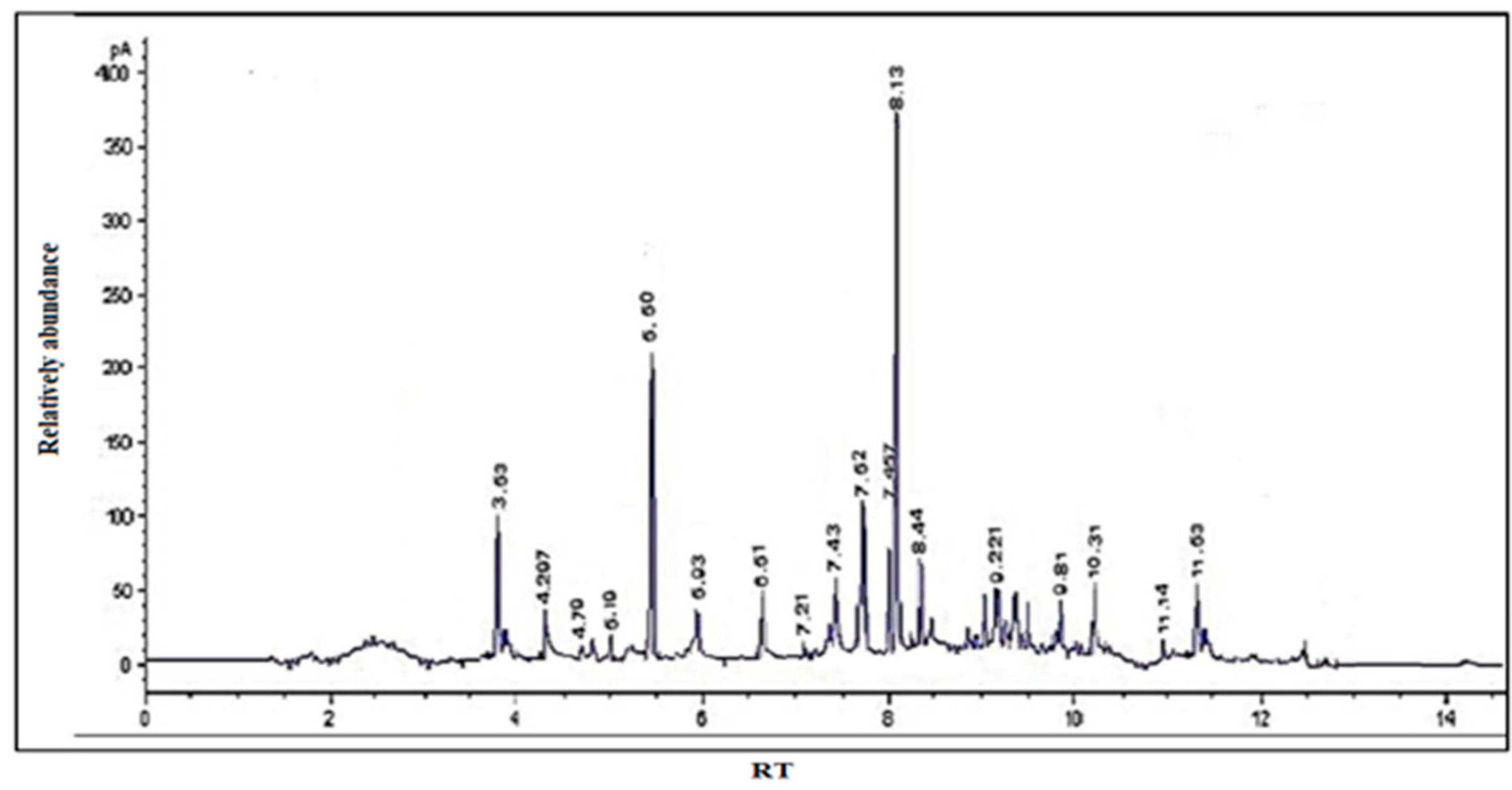
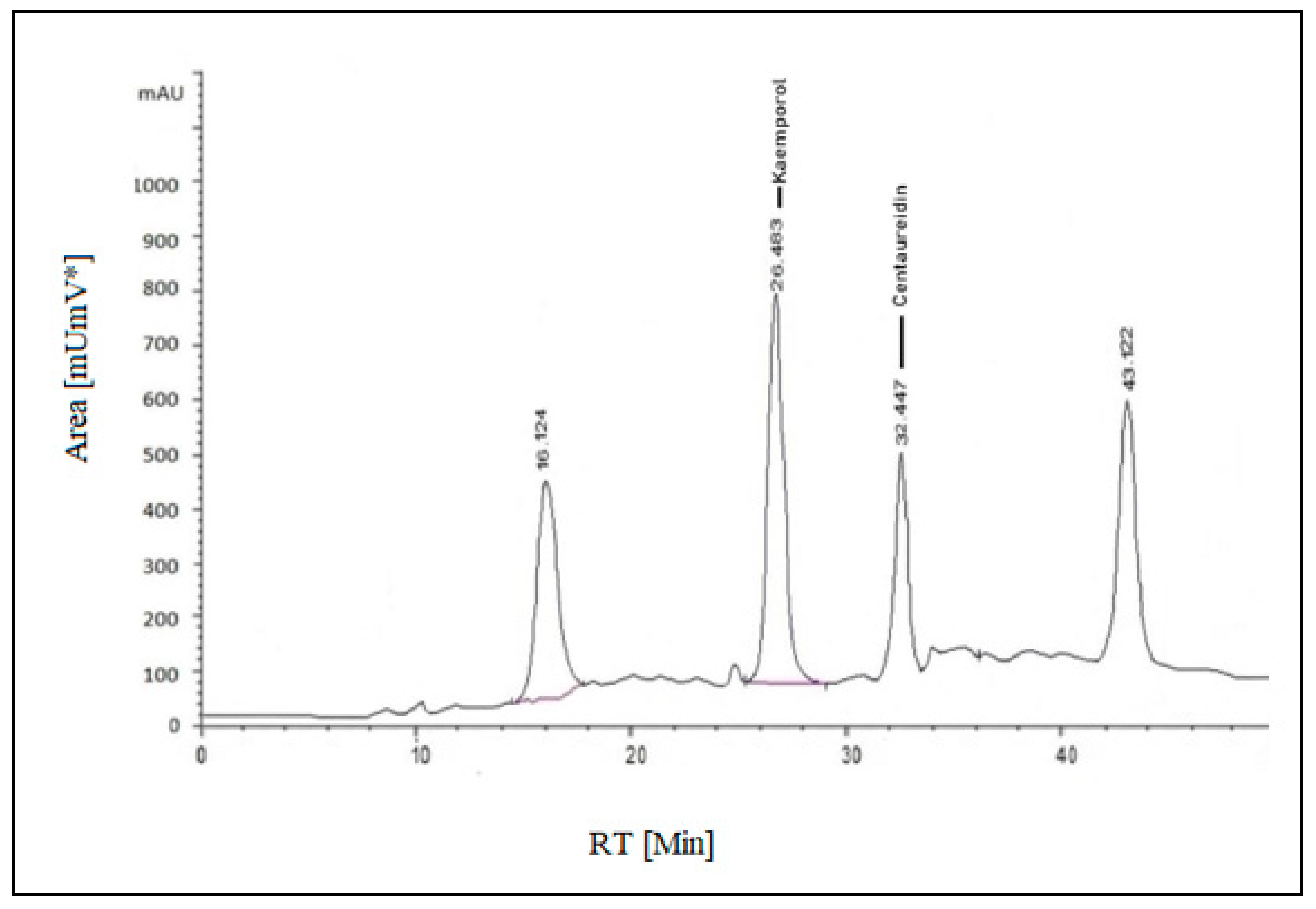

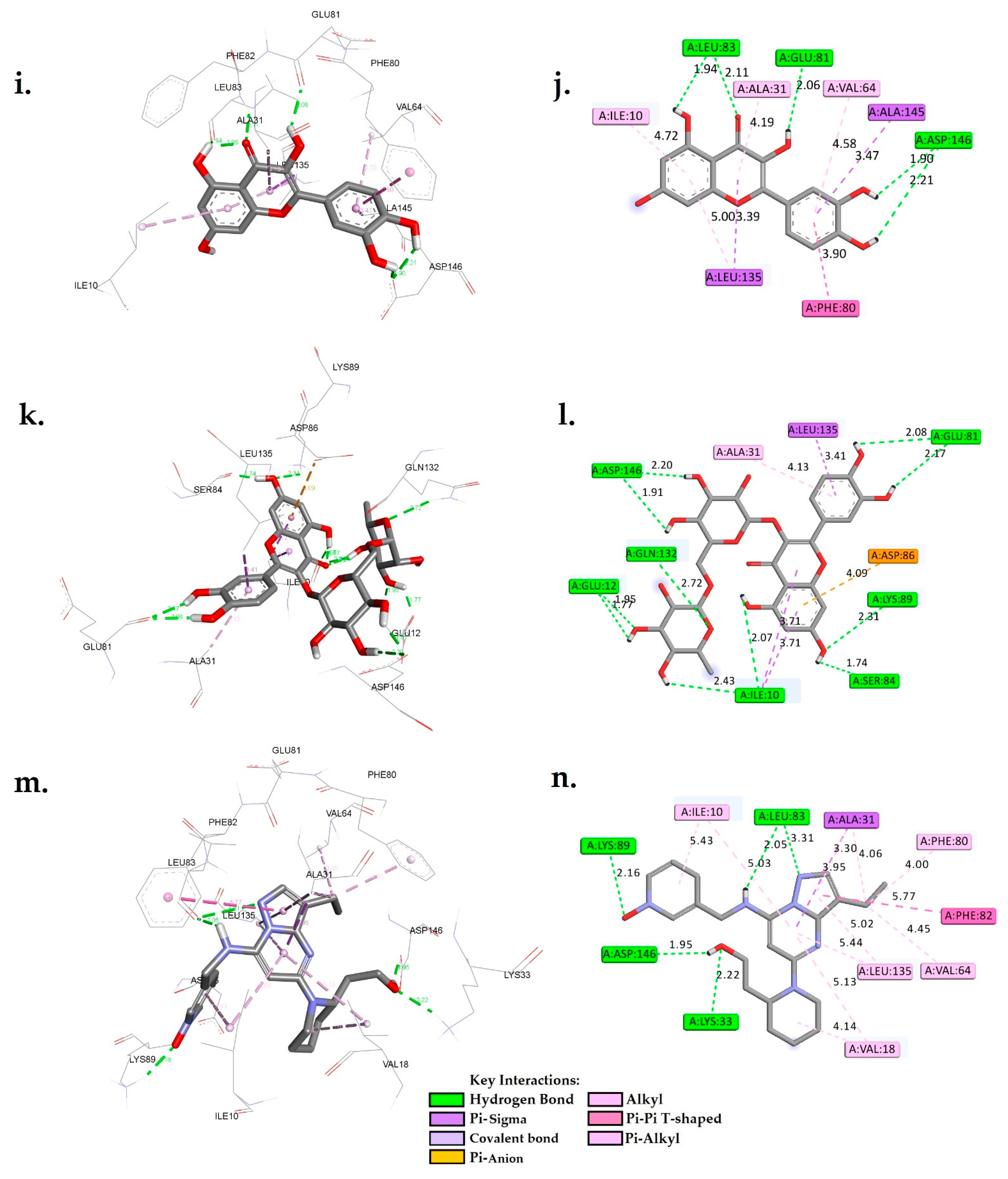
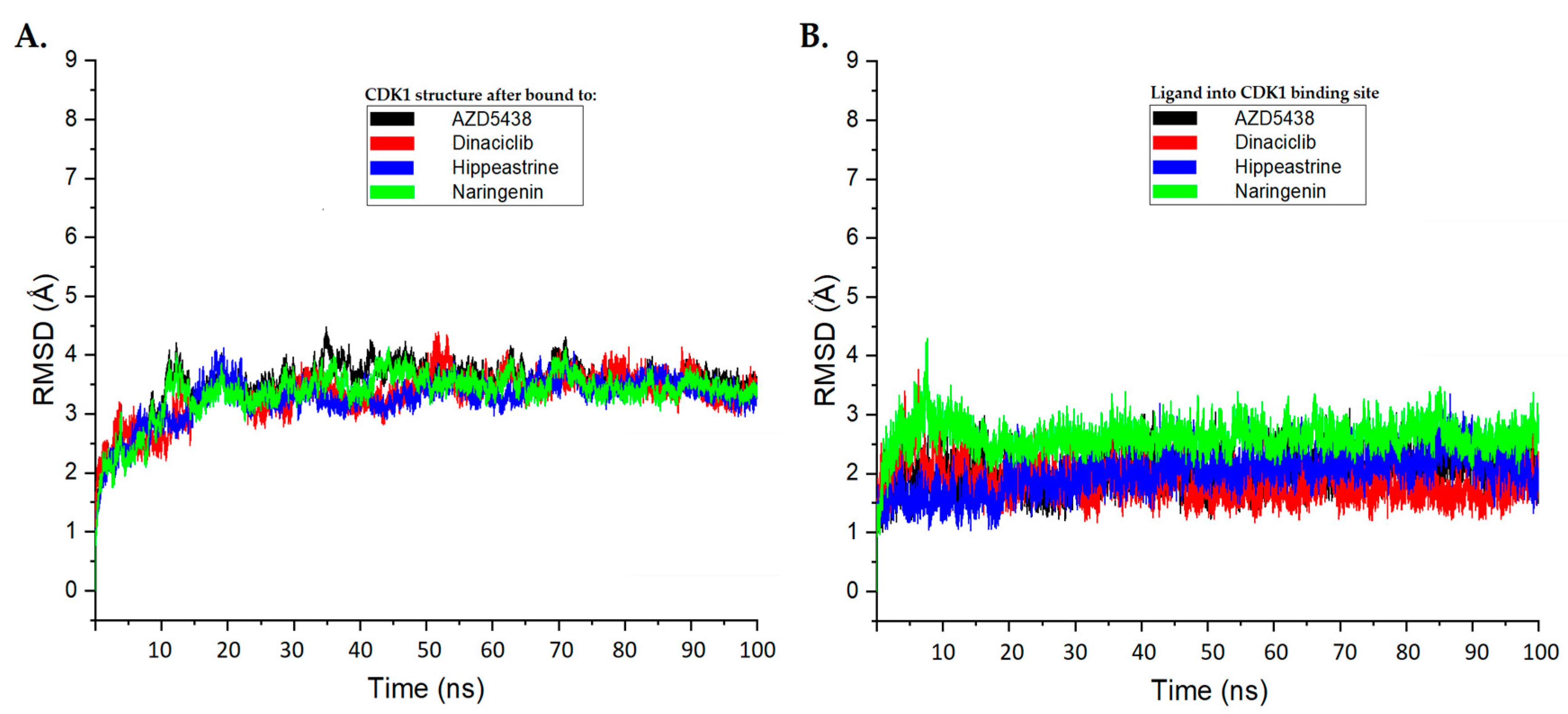
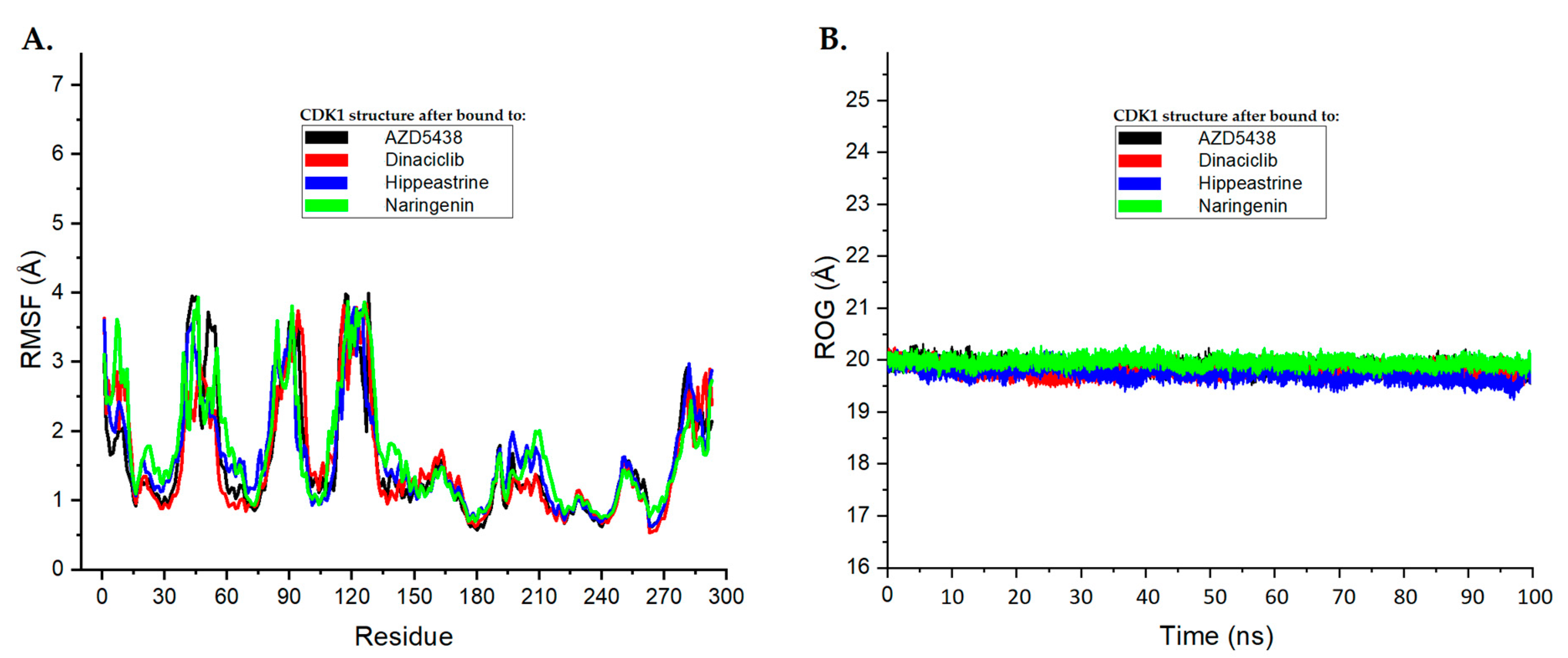
| Component Name | RT (min) | Area % |
|---|---|---|
| Cyclopentane | 3.63 | 8.12 |
| 8-Nonynoic acid | 4.20 | 3.07 |
| 5-Hydroxymethylfurfural | 5.50 | 16.31 |
| 4-Vinylguaiacol | 5.93 | 2.81 |
| Eugenol | 6.51 | 18.44 |
| Hippeastrine | 4.43 | 2.00 |
| Vanillin | 5.93 | 2.46 |
| α-Curcumene | 6.51 | 3.89 |
| α-Bergamotene | 7.52 | 7.76 |
| Carbanilic acid | 7.45 | 7.35 |
| Gingerone | 8.13 | 25.67 |
| Didodecyl phthalate | 8.44 | 6.86 |
| Cholestan-3-ol | 9.22 | 2.33 |
| Gingerol | 10.31 | 4.02 |
| # | Phytochemicals | CDK1 (6GU7.PDB) |
|---|---|---|
| Docking Score (kcal/mol) | ||
| 1 | 4-Vinylguaiacol | −5.53 |
| 2 | 5-Hydroxymethylfurfural | −6.36 |
| 3 | 8-Nonynoic acid | −6.21 |
| 4 | Apigenin | −6.97 |
| 5 | Carbanilic acid | −4.01 |
| 6 | Centaureidin | −7.01 |
| 7 | Cholestan-3-ol | −8.69 |
| 8 | Cyclopentane | −6.99 |
| 9 | Didodecyl phthalate | −6.74 |
| 10 | Diosgenin | −9.31 |
| 11 | Eugenol | −5.99 |
| 12 | Gallic acid | −6.32 |
| 13 | Gingerol | −7.14 |
| 14 | Gingerone | −5.65 |
| 15 | Hippeastrine | −9.42 |
| 16 | Kaempferol | −7.11 |
| 17 | Kaempferol-3-O-glucuronide | −7.37 |
| 18 | Luteolin | −7.24 |
| 19 | Naringenin | −10.41 |
| 20 | Quercetin | −10.63 |
| 21 | Rutin | −11.92 |
| 22 | Vanillin | −6.87 |
| 23 | α- Curcumene | −5.95 |
| 24 | α-Bergamotene | −6.48 |
| AZD5438 (co-crystalized ligand) | −8.44 | |
| Dinaciclib (experimental control) | −10.38 |
| Phytochemicals | Physicochemical Properties | Drug-Likeness Observed | ||||||||
|---|---|---|---|---|---|---|---|---|---|---|
| *MW (g/mol) | *MR | *TPSA (Å2) | *LogP | Water Solubility | Lipinski | Ghose | Veber | Egan | Muegge | |
| Cholestan-3-ol | 388.67 | 124.09 | 20.23 | 7.47 | Poorly soluble | No | No | Yes | No | No |
| Diosgenin | 414.62 | 121.59 | 38.69 | 5.71 | Poorly soluble | No | No | Yes | Yes | No |
| Hippeastrine | 315.32 | 83.56 | 68.23 | 0.66 | Very soluble | Yes | Yes | Yes | Yes | Yes |
| Naringenin | 272.25 | 71.57 | 86.99 | 2.19 | Soluble | Yes | Yes | Yes | Yes | Yes |
| Quercetin | 302.24 | 78.03 | 131.36 | 1.99 | Soluble | Yes | Yes | Yes | Yes | Yes |
| Rutin | 610.52 | 141.38 | 269.43 | −1.69 | Moderately soluble | No | No | No | No | No |
| Dinaciclib | 396.49 | 117.94 | 91.15 | 1.55 | Soluble | Yes | Yes | Yes | Yes | Yes |
| Phytochemicals | Pharmacokinetics Properties | Toxicological Properties | |||||
|---|---|---|---|---|---|---|---|
| GI Absorption | Cross BBB | Pgp Substrate | CYP2C19 Inhibitor | AMES toxicity | Max Tolerated Dose (human) log mg/kg/day | Oral Rat Acute Toxicity (LD50) mol/kg | |
| Cholestan-3-ol | Low | No | No | No | No | −0.693 | 2.396 |
| Diosgenin | High | Yes | No | No | No | −0.559 | 1.921 |
| Hippeastrine | High | No | Yes | No | No | −0.459 | 2.492 |
| Naringenin | High | No | Yes | No | No | −0.176 | 1.791 |
| Quercetin | High | No | No | No | No | 0.499 | 2.471 |
| Rutin | Low | No | Yes | No | No | 0.452 | 2.491 |
| Dinaciclib | High | No | Yes | No | No | −0.328 | 2.626 |
| System | ΔGBinding (kJ/mol) | Electrostatic (kJ/mol) | Van der Waal (kJ/mol) | Polar Solvation (kJ/mol) | Non-Polar Solvation (kJ/mol) |
|---|---|---|---|---|---|
| CDK1-AZD5438 | −52.03 | −34.01 | −28.63 | 26.94 | −16.33 |
| CDK1-Dinaciclib | −59.41 | −37.16 | −31.24 | 23.63 | −14.64 |
| CDK1-Hippeastrine | −55.06 | −34.35 | −30.53 | 26.31 | −16.49 |
| CDK1-Naringenin | −54.08 | −31.15 | −29.47 | 21.76 | −15.22 |
| Mobile Phase Grades (Flow Rate 0.8 mL/min) | Time | |
|---|---|---|
| A (0.1% phosphoric acid in water) | 95 | 0 |
| 5–25 | 0–0.5 | |
| 80–90 | 0.5–2 | |
| 10–60 | 2–4.5 | |
| 50–60 | 4.5–8 | |
| 0 | 8–14 | |
| B (100% HPLC grade methanol) | 5 | 0 |
| 95–75 | 0–0.5 | |
| 20–10 | 0.5–2 | |
| 90–40 | 2–4.5 | |
| 50–40 | 4.5–8 | |
| 100 | 8–14 | |
Disclaimer/Publisher’s Note: The statements, opinions and data contained in all publications are solely those of the individual author(s) and contributor(s) and not of MDPI and/or the editor(s). MDPI and/or the editor(s) disclaim responsibility for any injury to people or property resulting from any ideas, methods, instructions or products referred to in the content. |
© 2023 by the authors. Licensee MDPI, Basel, Switzerland. This article is an open access article distributed under the terms and conditions of the Creative Commons Attribution (CC BY) license (https://creativecommons.org/licenses/by/4.0/).
Share and Cite
Abdelbagi, M.E.M.; Al-Mazaideh, G.M.; Ahmed, A.E.; Al-Rimawi, F.; Ayyal Salman, H.; Almutairi, A.; Abuilaiwi, F.A.; Wedian, F. Exploring Securigera securidaca Seeds as a Source of Potential CDK1 Inhibitors: Identification of Hippeastrine and Naringenin as Promising Hit Candidates. Processes 2023, 11, 1478. https://doi.org/10.3390/pr11051478
Abdelbagi MEM, Al-Mazaideh GM, Ahmed AE, Al-Rimawi F, Ayyal Salman H, Almutairi A, Abuilaiwi FA, Wedian F. Exploring Securigera securidaca Seeds as a Source of Potential CDK1 Inhibitors: Identification of Hippeastrine and Naringenin as Promising Hit Candidates. Processes. 2023; 11(5):1478. https://doi.org/10.3390/pr11051478
Chicago/Turabian StyleAbdelbagi, Mohamed E. M., Ghassab M. Al-Mazaideh, Adil Elhag Ahmed, Fuad Al-Rimawi, Haya Ayyal Salman, Abdulrahman Almutairi, Faraj Ahmad Abuilaiwi, and Fadel Wedian. 2023. "Exploring Securigera securidaca Seeds as a Source of Potential CDK1 Inhibitors: Identification of Hippeastrine and Naringenin as Promising Hit Candidates" Processes 11, no. 5: 1478. https://doi.org/10.3390/pr11051478






